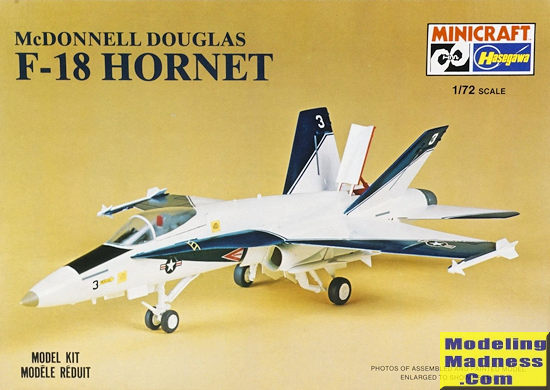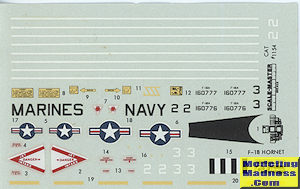
Minicraft/Hasegawa 1/72 F-18 Hornet
| KIT #: | 1154 |
| PRICE: | @$5.00 when new |
| DECALS: | Two options |
| REVIEWER: | TScott Van Aken |
| NOTES: | Initial, unmodified tooling |

| HISTORY |
The F-18, initially known as McDonnell Douglas Model 267, was drastically modified from the YF-17. For carrier operations, the airframe, undercarriage, and tailhook were strengthened, folding wings and catapult attachments were added, and the landing gear widened. To meet Navy range and reserves requirements, McDonnell increased fuel capacity by 4,460 pounds (2,020 kg), by enlarging the dorsal spine and adding a 96-gallon fuel tank to each wing. A "snag" was added to the wing's leading edge and stabilators to prevent an Aeroelastic flutter discovered in the F-15 stabilator. The wings and stabilators were enlarged, the aft fuselage widened by 4 inches (102 mm), and the engines canted outward at the front. These changes added 10,000 lb (4,540 kg) to the gross weight, bringing it to 37,000 lb (16,800 kg). The YF-17's control system was replaced with a fully digital fly-by-wire system with quadruple-redundancy, the first to be installed in a production fighter.
| THE KIT |
 Back in the 1970s and early 1980s, it was not unusual for model kit companies to rush into production models of aircraft that were still in prototype stages. I should say 'pre-production' as about this time, the services no longer did 'prototypes'. I'm not sure why, but there it is. The first F-18s were F-18As, though they were pre-production planes that were used for various tests. These planes were often modified somewhere along the way when issues arose that required changes. It is the way of developing aircraft.
Back in the 1970s and early 1980s, it was not unusual for model kit companies to rush into production models of aircraft that were still in prototype stages. I should say 'pre-production' as about this time, the services no longer did 'prototypes'. I'm not sure why, but there it is. The first F-18s were F-18As, though they were pre-production planes that were used for various tests. These planes were often modified somewhere along the way when issues arose that required changes. It is the way of developing aircraft.
During this time, Hasegawa kits were imported by Minicraft. These Minicraft kits initially were identical to the Hasegawa versions save for the box top and instructions exchanging Japanese for English. Later, when model makers knee-jerked as a result in truth in advertising, the boxes changed considerably with photos of built models on the cover. Minicraft also swapped out the Hasegawa decals with those produced by Scalemaster. Unfortunately, Scalemaster decals were frequently off register and this sheet is no exception.
So this kit can only be built as a pre-production airframe unless the modeler wants to break out the filler. Of course, Hasegawa isn't the only company that did this for ESCI's initial F-18 was the same. What one has to do to bring this up to production specs is fill in the area between the dogtooth and the fuselage on the horizontal stab. Fill in the first 80% of the slot in the LEREX. Finally remove the dogtooth from the wing. It seems to me that a wedge of plastic on the wing should deal with that issue.
In all respects aside from the items mentioned, the rest of the kit is exactly the same as what is currently available from Hasegawa. the benefit of this kit is that the moldings are fresh so there isn't the issues with worn tooling that one has with kits that have been produced for decades. This kit also has the long nose probe use d on many of the pre-production aircraft.
d on many of the pre-production aircraft.
One thing this kit is lacking that later kits have are pylons and external fuel tanks. This kit has a smooth lower wing, something added with the newer tooling that included the wing, stabs, upper fuselage and fins. As usual, decals are used for the instrument panel.
Instructions are well drawn and though probably unusable, the off register decals can be used for several of the markings. Both decal options have large areas of blue and the decals include the white cheat lines. You can model aircraft #3 or #4. Tail hook stripes and a nose anti-glare panel are included.
| CONCLUSIONS |
Basically, this is a kit you build if you want to do an early, unmodified pre-production airframe. If you want a production plane you'll need to perform the work mentioned and scrounge pylons and fuel tanks from another source.
| REFERENCES |
https://en.wikipedia.org/wiki/McDonnell_Douglas_F/A-18_Hornet
October 2016 Copyright ModelingMadness.com. All rights reserved. If you would like your product reviewed fairly and fairly quickly, please contact the editor or see other details in the